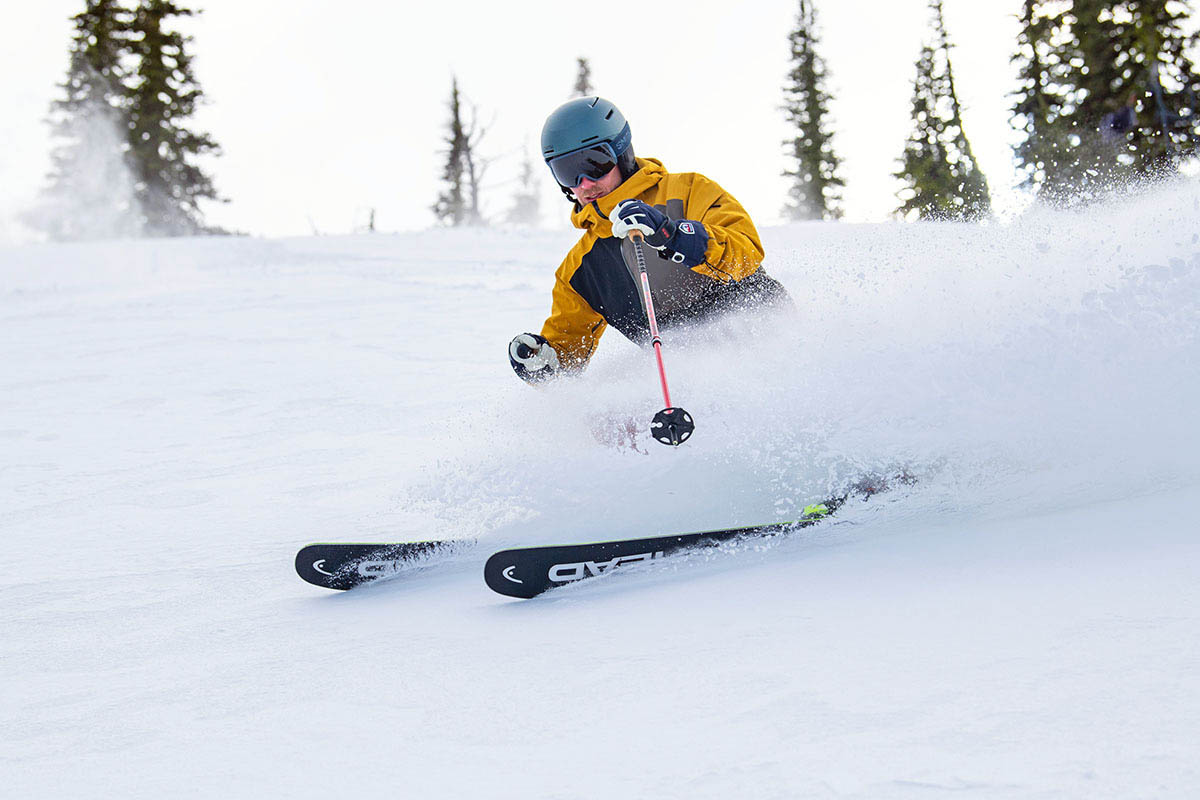
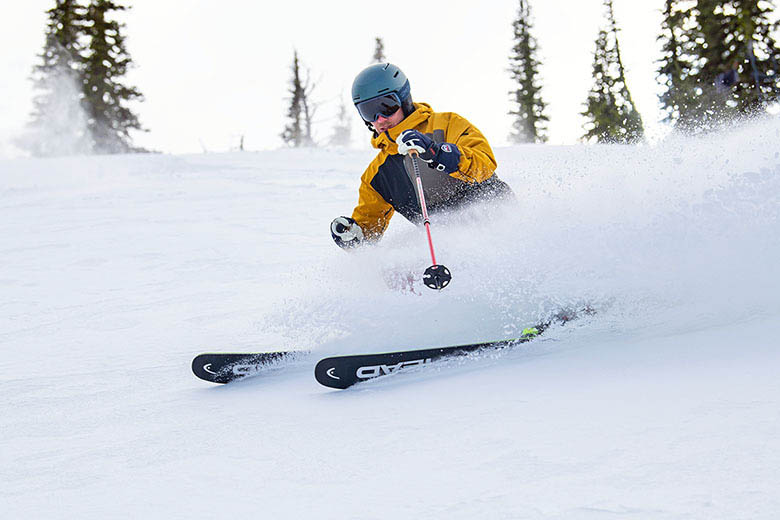
Switchback Travel (Jason Hummel)
It’s hard not to admire the utility of a pair of ski poles: They can help you set a rhythm for turns, propel you along flat sections of trail, or serve as a crutch to lean on in long lift lines. We’ve tested dozens of options over the years, from downhill poles intended for running laps at the resort to light and adjustable designs for long slogs into the backcountry. Since the poles you choose will largely depend on where you spend most of your time, our top picks for the 2024-2025 season are broken down into two categories: downhill poles and backcountry poles. For more background information, see our comparison tables and buying advice below the picks, along with details about our testing practices.
Editor’s note: We updated this guide on November 26, 2024, to add the Völkl Phantastick, Salomon Polar Pro S3 (replacing the Arctic S3), Black Diamond Traverse, and Black Diamond Traverse Compactor (replacing the standard Compactor). We also incorporated several photos from a recent testing trip on Mt. Rainier.
 Shaft: Aluminum (16mm)
Shaft: Aluminum (16mm)
Baskets: Standard, powder
Weight per pair: 1 lb. 1.0 oz. (120cm)
What we like: Ergonomic grip and slick strap system.
What we don’t: Pricey for an aluminum pole.
For all-mountain skiing, sturdy aluminum poles make the most sense. They’re durable—usually bending from a hard impact rather than breaking like carbon fiber—and plenty lightweight for days at the resort. Our favorite aluminum downhill pole is the Leki Detect S, which hits the mark with its tough construction, ergonomic grips, and innovative strap system that we outline below. The Detect lacks the weightless feeling of a full carbon design, but it’s reasonably light at just over a pound per pair, has a noticeably durable feel that should hold up well over the long term, and undercuts most carbon poles by $20 or more. Taken together, it’s a well-rounded design that checks all the boxes for most resort-goers.
The “S” in the name stands for Leki’s Trigger S system, which allows you to separate the strap from the pole. We’ve found it practical for getting on and off the chairlift, although the time saved is pretty minimal. There also is a safety element to the design: A built-in spring will release the strap under upward tension, disconnecting you from a potentially hazardous swinging ski pole. Added up, its combination of performance, features, and price make the Detect S our favorite all-around ski pole on the market for the 2024-2025 season. A couple other quality designs from Leki to have on your radar are the Bold Lite S, which costs the same but features different grips and straps and boasts an ice tip for firmer conditions, and the Qntm Pole, a cheaper ($70) but less premium alternative with a streamlined strap design.
See the Leki Detect S
 Shaft: Aluminum (18mm)
Shaft: Aluminum (18mm)
Basket: Powder
What we like: All the weekend resort skier really needs at a hard-to-beat price.
What we don’t: Not a performance ski pole; no longer comes with two baskets.
Ski poles aren’t all that exciting, but Völkl’s Phantastick does an admirable job of pumping some life into a relatively simple design. Specifically, the range of colors (including yellow, green, and red) and vibrant grips stand out among a pretty dull crowd of competitors. It also helps that they’re priced right at $59 and tough with an 18-millimeter diameter shaft, making them among the most popular ski poles on the market. The latest version only comes with powder baskets—past models included both standard and powder baskets—but the all-around value remains hard to beat.
Outside of the flashy appearance, the poles are standard fare but plenty good for most downhill skiers. The alloy construction is heavier than carbon or even premium aluminum (note: Völkl does offer a thinner 16mm variation, as well as a $99 carbon model). The Phantastick also lacks the slick strap system of poles like the Leki above, but it’s significantly cheaper than a “performance” ski pole. And that extra money could instead be allocated to better skis or boots—gear that will have a much more significant impact on true performance. For these reasons, the Völkl Phantastick is our favorite budget option. Of note: The women's-specific version of this pole is only available in a 16-millimeter diameter but will also save you about $10.
See the Völkl Phantastick See the Women's Völkl Phantastick
 Shaft: Carbon composite (22mm)
Shaft: Carbon composite (22mm)
Basket: Powder
Weight per pair: 1 lb. 1.6 oz.
What we like: A light-but-tough option that can hold its own in deep powder.
What we don’t: Expensive for only modest weight savings and basic grips.
In contrast to the aluminum models above, Black Crows opted for carbon composite with their premium Furtis poles. While this often translates to a drop in durability—carbon is vulnerable to breaking from hard impacts—Black Crows did a good job combatting the typical pitfalls by using a beefed-up, 22-millimeter shaft (the thickest on our list by 4mm). This doesn’t fundamentally change carbon’s tendency to crack under stress, but it would take a lot of force to snap these poles. And if weight matters to you, the Furtis checks in at just over 1 pound per pair and feels very light in the hands.
The biggest downside of the Black Crows Furtis—which isn't all that surprising given its carbon build—is cost. In fact, at $180, it’s the priciest downhill design to make our list, followed closely by Leki’s $170 Carbon 14 3D below (although that pole uses a much thinner 14mm shaft that won’t stand up as well to long-term, aggressive use). Another drawback to the Furtis is its round and fairly basic grip, which isn’t as comfortable for all-day use as more upgraded, ergonomic designs. Finally, casual resort-goers who don’t care too much about weight can save considerably with a simple aluminum model like Black Crows’ own Meta below. But we really like the Furtis for its balance of weight and sturdiness, and the 90-millimeter powder basket and extended grips make it a viable option for the occasional tour. For a cheaper carbon option from Black Crows, check out their popular Stans, which has a noticeably thinner (13mm) shaft but will save you a considerable $70.
See the Black Crows Furtis
 Shaft: Aluminum (18mm)
Shaft: Aluminum (18mm)
Basket: Standard
What we like: Cheap, simple, and does the trick.
What we don’t: Very basic feature set and susceptible to bending.
Stepping down in price from the Völkl Phantastick above are Evo’s value-oriented Merge Ski Poles. The case for these is simple: They’re $50, offered in a nice range of colors (four at the time of publishing), and hit the mark for casual resort use with an 18-millimeter aluminum shaft, average-sized grips, and a standard, hardpack-friendly basket. And did we mention they’re $50? That makes the Merge the most affordable pick to make our list, and they often cost even less during sale periods.
For the price, the quality of these poles is surprisingly high—one benefit of buying from Evo’s in-house brand—but it’s important to set reasonable expectations in terms of performance. You don’t get the barely-there feeling of a premium option, the grips aren't comfortable with their hard-plastic construction, and the aluminum build tends to bend under heavy stress. Additionally, the standard discs will sink quickly in the deep stuff. But for casual resort riders who don't set overly lofty expectations, there's very little to complain about. For a step up in performance, Evo also offers the $65 Refract, which boasts a more durable 7075 aluminum build and wider baskets for all-mountain use.
See the Evo Merge
 Shaft: Aluminum (18mm/16mm)
Shaft: Aluminum (18mm/16mm)
Basket: Standard
Weight per pair: 1 lb. 1.6 oz.
What we like: Tough, affordable, and includes Salomon’s auto-release strap for added safety.
What we don’t: Only comes with one basket and doesn’t stand out in any other area.
Joining the Völkl Phantastick and Evo Merge above is another high-quality but affordable ski pole to have on your radar: Salomon’s Polar Pro S3. For around $10 more than the Phantastick, the Salomon is another tough, no-nonsense downhill design with a sturdy shaft (18mm at the top and 16mm at the bottom) that will stand up well to aggressive resort riding. As its name suggests, the Polar Pro also includes Salomon’s S3 safety technology, which is similar to Atomic’s SQS tech featured in their BCT Freeride poles below and designed to automatically disconnect the strap from the pole in the event of a fall. The rest of the design is decidedly basic (including just a single all-mountain basket), but the Polar Pro checks all of the boxes for most resort skiers at a very approachable price point.
As we touched on above, the Salomon Polar Pro S3 and Völkl Phantastick offer similar overall performance. We rank the Phantastick higher because it wins out in price by $11, but the S3’s auto-release strap certainly has its appeal for new riders and those who want a little added assurance when pushing their limits. On the flip side, the Völkl is the slightly more hardwearing option with 18-millimeter aluminum throughout, while the Polar Pro streamlines things at the bottom with a 16-millimeter shaft (importantly, both poles utilize 7075 aluminum, which is stronger than the 5083 variety that Evo employs with their Merge above). Value-wise, the two designs are similarly competitive, and a final decision will likely come down to whether or not you want the S3 tech. For $20 more, we also like Salomon’s Hacker S3, which is slightly more robust with 18-millimeter aluminum throughout and comes with wider baskets for exploring the backside.
See the Salomon Polar Pro S3
 Shaft: Carbon fiber (14mm)
Shaft: Carbon fiber (14mm)
Basket: Standard
Weight per pair: 1 lb. 0.5 oz. (120cm)
What we like: Premium build, feathery feel, and Trigger 3D system adds an extra dose of safety.
What we don’t: Thin construction and standard baskets limit overall appeal.
Leki’s Carbon 14 3D is a more premium resort design but packs in a ton of tech for the price. With the latest update to their popular Trigger strap system, Leki increased the release angle to 220 degrees, making it easier to disconnect in the event of a crash. The feel and swing weight are fantastic, and the carbon fiber has a nice flex for effortless transitions between turns (aluminum feels stiff by comparison). With only a 14-millimeter diameter, the Carbon 14 3D is decidedly thin, but the high-quality build holds up well to everyday downhill punishment—provided you exercise reasonable caution and stay away from the terrain park.
As with other pure carbon ski poles, the Leki’s biggest downsides are price and durability. At $170, it’s the second-most-expensive downhill ski pole to make our list this season, and the thin construction and standard baskets limit the Carbon 14 3D’s usefulness to bombing down groomed runs. For reference, the Black Crows Furtis above comes with wider and more versatile powder baskets—along with a thicker and more durable carbon composite construction—for just $10 more and a negligible weight penalty. But for those who can afford it and ski enough to enjoy it, the Carbon 14 3D is another great high-end ski pole from one of the best brands in the business. For a cheaper aluminum option that shares many of the same features, see Leki’s Spitfire 3D.
See the Leki Carbon 14 3D
 Shaft: Aluminum (18mm)
Shaft: Aluminum (18mm)
Basket: Powder
Weight per pair: 1 lb. 0.9 oz. (120cm)
What we like: A functional, good-looking all-mountain design at a great price.
What we don’t: No hardpack baskets; less of a value than the Völkl Phantastick above.
Black Crows is known for their colorful and contemporary skis, and that personality trickles down nicely into their ski pole collection. The Meta is a case in point: For just $65, you get a great-looking pole with poppy chevron patterning (many of their skis display similar shapes on their topsheets) and a nice selection of bright colorways. And unlike the similarly budget-friendly Salomon Polar Pro S3 above, the Meta boasts wide powder baskets that make it the more capable choice for sidecountry use and areas that get consistently good snowfall.
It’s worth noting that Black Crows opted for 5083-grade aluminum here, which is decently strong for its weight (Evo's $15-cheaper Merge above uses the same type of alloy) but less premium than the 7075 variety featured in the Völkl Phantastick and Salmon Polar Pro S3 above. Hitting big drops or features at the park wreaks havoc on all ski pole designs, but the Black Crows are well equipped to handle regular use and abuse. We do wish the poles also came with smaller-diameter hardpack baskets for high-speed use on groomers, but for only $65, the Meta is an impressively well-rounded and fun option that’s sure to stand out on the slopes.
See the Black Crows Meta
 Shaft: Aluminum
Shaft: Aluminum
Basket: Powder
Weight per pair: 1 lb. 4.8 oz.
What we like: Tough, reliable build with Atomic’s handy strap safety feature.
What we don’t: The most expensive aluminum alpine poles on our list; relatively heavy.
Atomic is a stalwart in the ski industry, and their BCT Freeride SQS pole is a tough, no-nonsense design for freeriders who frequently venture off-trail and into the sidecountry. One clear strong suit is durability: The quality 7075 aluminum makes for a robust pole built for aggressive riding. And Atomic also included their SQS technology—short for Safety Quick Release System—which disconnects the strap from the pole if it gets caught on a tree or chairlift (similar to Salomon’s S3 tech included in their Polar Pro poles above). This added safety feature, along with the BCT Freeride’s sturdy construction, makes it a great option for anything from carving groomers to taking big hits in the terrain park.
At $120, the Atomic BCT Freeride SQS falls into a bit of an awkward spot price-wise: It’s cheaper than carbon options like the Leki Carbon 14 3D and Black Crows Furtis above but pricier than aluminum designs like the Evo Merge ($50), Völkl Phantastick ($59), and Salomon Polar Pro S3 ($70), all of which are also very tough and reliable. As we touched on above, the Polar Pro also features a similar auto-release strap, and both poles use durable 7075 aluminum that will hold up well over the long term (although the Salomon uses slightly thinner 16mm aluminum at the bottom). The net result is that the Atomic isn’t a great value, but the BCT Freeride SQS leaves little to be desired in terms of all-around performance and durability. For those looking to shave weight, Atomic’s AMT Ultra SQS (15.2 oz.) costs the same but swaps in a carbon shaft and a narrower, on-piste basket.
See the Atomic BCT Freeride SQS
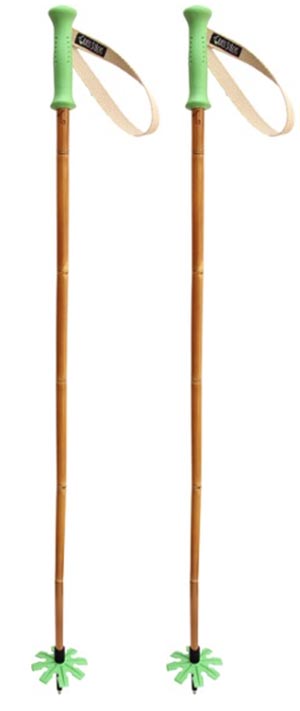 Shaft: Bamboo
Shaft: Bamboo
Basket: Standard
Weight per pair: 1 lb. 2.0 oz.
What we like: Strong sustainability focus, highly customizable, and made in the U.S.
What we don’t: Fairly basic for the price and less proven than the competition.
Unlike the options above, Grass Sticks uses an all-bamboo construction in their poles, and we think the material choice makes a lot of sense: Bamboo is reasonably strong but still flexible enough to bend rather than snap under pressure, and it doesn’t require the same amount of resources to manufacture and produce as aluminum or carbon. Further, these poles are made in the U.S. (in the ski town of Steamboat Springs, Colorado, to be exact) and stand out among the fairly dull and muted competition with their light-colored shafts and vibrant straps and grips. Plus, if you order directly through Grass Sticks, you can fully customize the poles by choosing the basket size, grip and basket color, desired length, and style and design of the straps (for an extra fee).
Why do we have the Original Bamboo poles ranked here? Despite the sustainability focus and trendy looks, these poles don’t have the time-tested track record of the models above. On the bright side, Grass Sticks does provide a generous two-year warranty on their poles (after that, they will replace each broken pole for $22 plus shipping or send a new pair for $42 plus shipping). Additionally, these poles are decidedly on the basic end of the spectrum, with simple rubber grips and only one included basket (you can purchase more separately), which detracts from all-around value. These concerns are enough to keep the bamboo poles off our podium, but they’re an undeniably fun option for those looking for something different.
See the Grass Sticks Original Bamboo
 Shaft: Aluminum (16mm)
Shaft: Aluminum (16mm)
Basket: Powder
Weight per pair: 1 lb. 2.3 oz.
What we like: Dependable construction, reasonably light, and a solid all-around value.
What we don’t: More basic than Black Diamond’s own Razor Carbon Pro below.
With backcountry ski gear, you’re constantly trying to balance weight with performance and durability, and nobody pulls that off better than Black Diamond. Their Traverse is our top choice for ski touring and finds that happy medium: The two-piece design has a durable aluminum shaft that’s as thick as many downhill poles at 16 millimeters but manages to keep weight in check at 1 pound 2.3 ounces. The rest of the design is equally well executed, including ergonomic rubber grips with a flat edge for scraping snow off skis, a hooked tip for flipping heel risers, and even an integrated screwdriver in the shaft for fine-tuning the FlickLock adjustment system (it also fits most bindings). A final feather in the Traverse’s cap is the $115 price tag, which undercuts most of the poles below.
It’s worth noting that we previously had Black Diamond’s own Razor Carbon Pro ranked here, but the Traverse drives a hard bargain. In comparing the two, the Traverse weighs around the same but features a more durable construction (the Razor Carbon Pro uses 14mm aluminum at the top and 12mm carbon fiber at the bottom), collapses down slightly smaller for securing to a pack, and will save you a considerable $65. The Razor Carbon Pro does include BD’s upgraded FlickLock Pro adjustment system, which we’ve found to be more robust and reliable overall (it’s made of stainless steel rather than plastic), along with breakaway straps for added safety in the event of a crash or the poles getting stuck in place. But dollar for dollar, we consider the Traverse the better all-around value and a well-rounded performer for most backcountry pursuits. Plus, it’s dependable enough to pull double duty on the occasional resort day, which we can’t say for the Razor Carbon Pro.
See the Black Diamond Traverse
 Shaft: Aluminum
Shaft: Aluminum
Basket: Powder
Weight per pair: 12.6 oz.
What we like: The cheapest and lightest backcountry poles on our list.
What we don’t: Some won’t love the non-adjustable build.
Most of the touring options on our list are adjustable in length, but there’s something to be said for the simplicity of a one-piece pole. Dynafit’s Tour is just that: You don’t get the ability to change length, but its burly, all-aluminum construction easily outperforms the competition in toughness. Along with the clear advantages in durability, the Tour is also the cheapest backcountry option on our list at just $80 without sacrificing much in the way of performance or features. We especially like the long grip extensions for navigating steep or uneven slopes and hooked tip for adjusting ski bindings or flipping risers without having to bend down. Tack on a scant 12.6-ounce weight for the pair—the lightest design to make our list this season—and the result is a feathery but reliable companion for long slogs into the backcountry.
The Dynafit Tour offers an undeniably great value, but the lack of adjustability will be a dealbreaker for some riders. We personally like being able to shorten our poles on the uphill and extend them for flat sections and when descending. It’s also helpful to be able to compress your poles if you need to go hands-free when navigating sketchy or scrambly terrain. On the flip side, the Tour won’t unexpectedly collapse when you plant, and the lack of moving parts is an obvious bonus when it comes to long-term durability. In the end, the Tour won’t be for everyone, but it’s a hardwearing option for aggressive riders who seek out big lines or are prone to bending their adjustable poles. Another quality fixed-length design that we like is Black Crows’ Oxus, although it’s a considerable $55 pricier than the Dynafit, checks in 2.6 ounces heavier, and has a more streamlined feature set (no generous grip extensions or hooked tip).
See the Dynafit Tour
 Shaft: Aluminum (18mm)
Shaft: Aluminum (18mm)
Basket: Powder
Weight per pair: 1 lb. 4.7 oz. (125cm)
What we like: Folding design is great for those looking to minimize packed size.
What we don’t: More complex and less sturdy than standard telescoping poles.
For the ultimate in packability, Black Diamond’s Traverse Compactor (a fresh take on the past-generation Compactor) is a logical choice. The three-piece folding design collapses down to a diminutive 15.7 inches and checks in at a reasonable 1 pound 4.7 ounces per pair (note: Both specs are for the 125cm length), which is impressive given the all-aluminum construction. And like the brand’s Razor Carbon Pro below, the Traverse Compactor uses BD’s FlickLock Pro adjustment system for dialing in fit, which we’ve found to be very user-friendly and reliable. Not all backcountry riders need such a compact packed size, but it’s super helpful for instances when your poles will spend a lot of time secured to your ski backpack or stuffed away—think splitboarding, snowshoeing, or throwing into a duffel bag or suitcase during travel.
All that said, the Traverse Compactor’s multi-section design translates to less sturdiness and rigidity. The thick aluminum build should stand up decently well to regular backcountry use, but the extra moving parts and components mean more potential failure points over time (the locking mechanisms and inner cables were particularly susceptible to issues with the past-generation model). But if you take good care of your gear and frequently want to be able to free up your hands, the Traverse Compactor is a well-executed design from a brand that specializes in remote mountain travel.
See the Black Diamond Traverse Compactor
![]() Shaft: Aluminum (16mm/14mm)
Shaft: Aluminum (16mm/14mm)
Basket: Powder
Weight per pair: 1 lb. 2.5 oz.
What we like: Great price for an adjustable and durable backcountry pole.
What we don’t: A little heavier than carbon and doesn’t collapse down very small.
Backcountry ski poles are an expensive bunch, but Leki’s $100 Helicon Lite hits a real sweet spot in terms of price and performance. For $20 more than the Dynafit Tour above, the Helicon boasts Leki’s proven Speed Lock + mechanism for customizing length depending on terrain or to stow in or on a pack, along with a mixed-thickness aluminum construction (16mm at the upper and 14mm at the lower) that’s confidence-inspiring for regular backcountry use. You also get premium touches like extended foam grips and a straight edge on each basket for tweaking bindings or removing ice buildup from your skins.
As we’ve covered above, aluminum is heavier than carbon, although the Leki Helicon Lite checks in at a reasonable 1 pound 2.5 ounces per pair. For reference, most similarly built designs are heavier, including Black Diamond’s 1-pound-2.3-ounce Traverse above and Atomic’s 1-pound-4.5-ounce Backland FR (not featured here). The Leki’s collapsed length isn’t particularly impressive at 37.4 inches, but it’s perfectly serviceable for securing to a pack occasionally. The Helicon Lite also undercuts both alternatives by $15 to $30, giving it the clear edge in value. In the end, you’d be hard-pressed to find a better mix of durability, weight, and overall performance for the price, earning the Helicon a respectable spot on our list for the 2024-2025 season.
See the Leki Helicon Lite
 Shaft: Aluminum
Shaft: Aluminum
Basket: Powder
Weight per pair: 1 lb. 0 oz.
What we like: Extra-long grips make it easy to adjust your hand position depending on terrain.
What we don’t: Unwieldy look and feel on the downhill; grips can ice up in frigid conditions.
Many of the designs on our list boast grip extensions for navigating steep or uneven terrain, but Folkrm’s Wyeast takes it to the next level with EVA grips that extend about halfway down the pole. The biggest benefit is convenience: The long section of foam means you can grab the pole pretty much anywhere, which is a boon when sidehilling or bootpacking (with other designs, you may have to adjust them mid-traverse or hold them by the cold metal shaft below the grip). The Wyeast also strikes a nice balance between durability and weight with a hardwearing 7075 aluminum construction that checks in at a very competitive 1 pound even for the pair. The rest of the design is relatively simple, although you do get nice touches like a removable strap and rubberized tip for flipping binding risers.
Designs like the Folkrm Wyeast are gaining popularity among backcountry riders, and we certainly understand the appeal. That said, there are some intricacies to consider. First, Folkrm recommends sizing the Wyeast longer (by 5-10cm) than your standard poles, which gives you more room to work when skinning up but results in a fairly unwieldy look and feel when descending (a good portion of the pole will be above your hand). One tester also found the grips prone to icing up and growing slippery in particularly cold and wet conditions, although they’re quick to dry. Combined with the polarizing looks, the Wyeast realistically has limited appeal. But for uphill-focused backcountry-goers looking for a tough, dependable design that can handle any terrain you throw at it, the Folkrm has its place. And if adjustability and collapsibility are on your must-have list, check out Folkrm’s Pahto, which is largely similar but tacks on a lever lock for tweaking the length (between 105 and 135cm).
See the Folkrm Wyeast
 Shaft: Aluminum (14mm)/carbon fiber (12mm)
Shaft: Aluminum (14mm)/carbon fiber (12mm)
Basket: Powder
Weight per pair: 1 lb. 2.5 oz. (100-125cm)
What we like: Light feel and premium build.
What we don’t: Expensive and more prone to durability issues than the Traverse above.
Black Diamond is a clear leader in the backcountry ski pole space, and the third model from their collection to make our list this season is the Razor Carbon Pro. As we touched on above, this pole was recently dethroned as our #1 pick but still has a lot going for it. Black Diamond uses our favorite adjustment system here, the FlickLock Pro, which has given us secure, slip-free support for both backpacking and skiing. All told, it’s glove-friendly, simple to use, and more trustworthy than the plastic FlickLock system featured on the Traverse above. Further, you get nice touches like a touring ring for choking up on short, steep sections or traverses and breakaway straps for added safety—both features that the Traverse lacks.
All that said, the Razor Carbon Pro makes some concessions to keep weight in check. The most notable is the thin (12mm) carbon fiber lower, which is far more susceptible to cracking than aluminum. In fact, one of our editors who works as a ski guide in the winter months has seen more than five pairs break in the field. To be fair, guiding can wreak havoc on any piece of equipment, but those who are particularly hard on their gear should consider a more robust design like the Traverse above. Alternatively, if adjustability isn’t a must-have for you, the Dynafit Tour and Folkrm Wyeast above are also cheaper and more dependable. But the Razor Carbon Pro’s lightweight feel and well-executed feature set are certainly selling points, and we know several backcountry riders who have had zero issues with durability over the years. For a step down in weight (15.8 oz.) and price ($150), we also like Dynafit’s Tour Vario ($150), which uses a similar mix of aluminum and carbon but forgoes the breakaway straps.
See the Black Diamond Razor Carbon Pro
 Shaft: Carbon fiber (16mm/14mm)
Shaft: Carbon fiber (16mm/14mm)
Basket: Powder
Weight per pair: 1 lb. 1.6 oz.
What we like: The lightest adjustable backcountry poles on our list.
What we don’t: Very expensive and prone to cracking.
Salomon is no stranger to demanding backcountry travel, and their MTN Carbon S3 poles are a nice reflection of the brand’s expertise in this realm. Right off the bat, we’ll note that the MTN is the only all-carbon backcountry pole to make our list, which has its pros and cons. On the bright side, these poles are some of the lightest here at just over 1 pound per pair, coming in just a few ounces heavier than Dynafit’s non-adjustable Tour (12.6 oz.) above. Salomon also beefed up the upper section with 16-millimeter carbon (the lower shaft is 14mm) and added Kevlar reinforcements at the bottom to fend off dents and dings from sharp ski edges, trees, and other trail obstacles. Aluminum is still the better match for aggressive riders who like to push their limits (it’s more prone to bending rather than snapping under pressure like carbon), but the MTN Carbon S3 is reasonably durable for an all-carbon design.
However, in addition to being less resistant to impacts, carbon also typically costs more than aluminum. The MTN Carbon S3 is no exception: At $200, they’re the priciest poles on our list and reserved for experienced backcountry riders who prioritize weight above all else. But price and durability aside, Salomon made very few other concessions: The MTN Carbon is premium in every way, from the mixed rubber and foam grips with generous choke-up extensions (similar to the Folkrm Wyeast above) to the rotating powder baskets that move around the shaft to adjust the angle of contact with the snow. Like their downhill-focused Polar Pro model above, the MTN Carbon also boasts Salomon’s S3 tech that detaches the strap from the pole in the event of a fall. Again, these all-carbon poles are a little specialized for most, but weight-focused backcountry riders will find a lot to like.
See the Salomon MTN Carbon S3
 Shaft: Aluminum (14mm)/carbon fiber (12mm)
Shaft: Aluminum (14mm)/carbon fiber (12mm)
Basket: Powder
Weight (single pole): 15.6 oz.
What we like: The ultimate ski mountaineering tool.
What we don’t: Expensive (sold as a single pole).
Ski mountaineering in steep, icy terrain comes with its own unique gear requirements, and the best ski mountaineering pole on the market is the distinctive Black Diamond Carbon Whippet. Sold as a single pole, the Whippet has a strong following in the backcountry community for its stainless steel pick at the front of the grip for self-arresting should you fall in a precarious spot. And Black Diamond updated the design fairly recently by adding a quick-release screw on the top of the grip, which allows you to easily remove the metal pick and store it while descending.
As with the other Black Diamond poles that made our list, the rest of the Whippet’s features are nicely thought out. Its two-piece construction is easy to adjust with the quality FlickLock Pro system, and it’s reasonably durable for a backcountry piece with a 14-millimeter aluminum upper and 12-millimeter carbon fiber lower (an all-aluminum Whippet is also offered for $150). Clearly, this is a specific tool for a certain type of skier—don’t even think about taking it to the resort—but the Carbon Whippet offers an unmatched level of security should you find yourself bootpacking up a sketchy ridgeline. And a final note: Black Diamond sells a couple of whippet attachments for $70 to $80, which can be screwed onto any of their poles with the WR (short for "Whippet Ready") designation.
See the Black Diamond Carbon Whippet
| Ski Pole | Price | Shaft | Weight | Baskets |
|---|---|---|---|---|
| Leki Detect S | $100 | Aluminum (16mm) | 1 lb. 1.0 oz. | Standard, powder |
| Völkl Phantastick | $59 | Aluminum (18mm) | Unavail. | Powder |
| Black Crows Furtis | $180 | Carbon composite (22mm) | 1 lb. 1.6 oz. | Powder |
| Evo Merge Ski Poles | $50 | Aluminum (18mm) | Unavail. | Standard |
| Salomon Polar Pro S3 | $70 | Aluminum (18mm/16mm) | 1 lb. 1.6 oz. | Standard |
| Leki Carbon 14 3D | $170 | Carbon fiber (14mm) | 1 lb. 0.5 oz. | Standard |
| Black Crows Meta | $65 | Aluminum (18mm) | 1 lb. 0.9 oz. | Powder |
| Atomic BCT Freeride SQS | $120 | Aluminum | 1 lb. 4.8 oz. | Powder |
| Grass Sticks Original Bamboo | $120 | Bamboo | 1 lb. 2.0 oz. | Standard |
| Ski Pole | Price | Shaft | Weight | Baskets |
|---|---|---|---|---|
| Black Diamond Traverse | $115 | Aluminum (16mm) | 1 lb. 2.3 oz. | Powder |
| Dynafit Tour | $80 | Aluminum | 12.6 oz. | Powder |
| Black Diamond Traverse Compactor | $175 | Aluminum (18mm) | 1 lb. 4.7 oz. | Powder |
| Leki Helicon Lite | $100 | Aluminum (16mm/14mm) | 1 lb. 2.5 oz. | Powder |
| Folkrm Wyeast | $120 | Aluminum | 1 lb. 0 oz. | Powder |
| Black Diamond Razor Carbon Pro | $180 | Aluminum (14mm)/carbon (12mm) | 1 lb. 2.5 oz. | Powder |
| Salomon MTN Carbon S3 | $200 | Carbon (16mm/14mm) | 1 lb. 1.6 oz. | Powder |
| Black Diamond Carbon Whippet | $190 | Aluminum (14mm)/carbon (12mm) | 15.6 oz. | Powder |
For most Switchback Travel staff members, skiing is a favorite and longstanding pastime. Former editor-in-chief and lifelong skier John Ellings compiled our initial list of 11 ski poles in 2015, which comprised both downhill and backcountry designs, along with women’s-specific poles. We’ve since dropped the final category due to the fact that women’s designs are often largely similar to unisex poles apart from smaller-diameter grips, a shorter size range, and different graphics. Managing editor Sarah Nelson began contributing to the guide in 2021 and now manages the round-up, adding her expertise as an avid resort skier formerly in Colorado and now along the shores of Lake Tahoe and throughout the Mountain West. To help dial in the backcountry picks, we consult our extensive network of gear testers and contributors who prefer to earn their turns outside the ropes.
Our collective experiences on the slopes have helped us whittle down our list to 17 picks (nine downhill designs and eight backcountry models). To evaluate performance, we take each pair of poles to the resort or deep into the backcountry, gauging their ability to withstand frequent use. We focus on key characteristics like grip comfort, length adjustability, and swing weight (how easy the poles are to flick around). Your ski pole preferences will likely vary depending on your experience level and intended use(s), which is why we’ve included everything from budget-friendly aluminum designs that will stand the test of time to much lighter (but less durable) all-carbon options. As the market evolves and changes, we’ll continue testing new and noteworthy contenders, adding any standout performers to the list above.
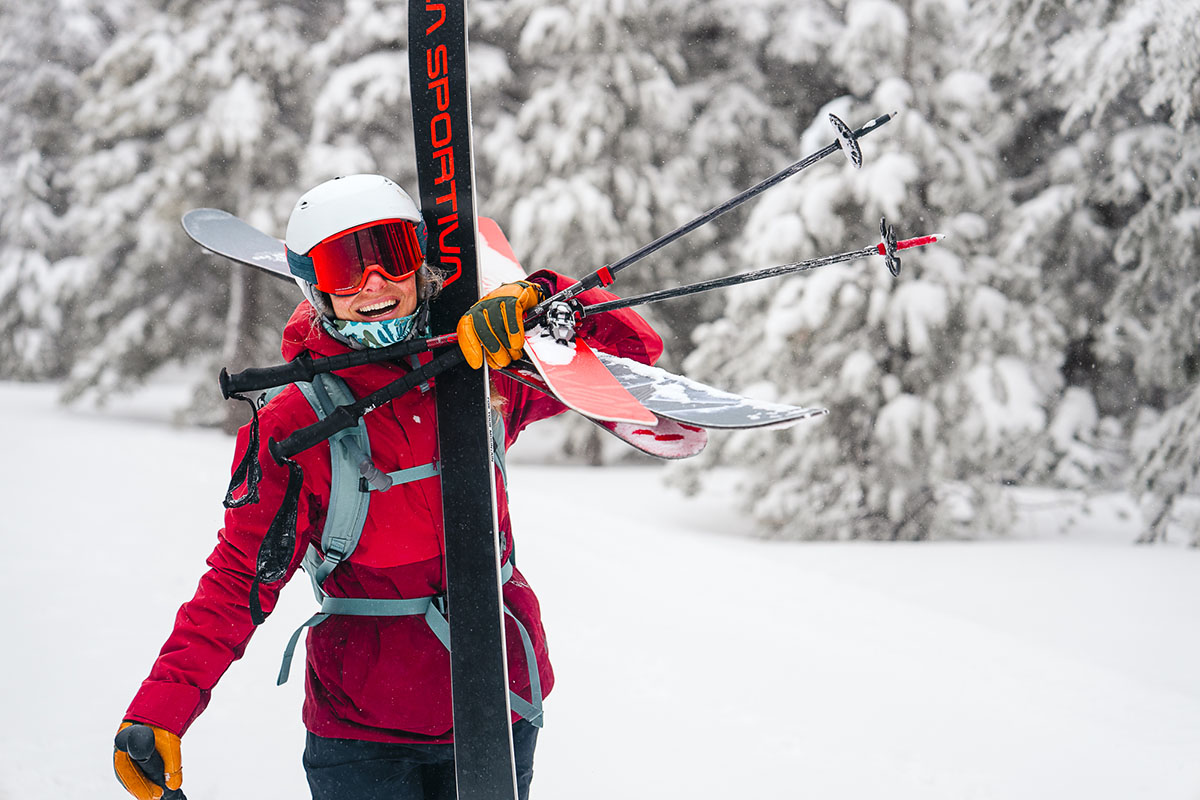
For the majority of skiers, purchasing a set of poles is either an afterthought or a necessity after breaking or losing an old pair. The good news is that it’s fairly easy to nail down which style is best for you. Below are common skier profiles and our recommended corresponding ski pole type:
.jpg)
Aluminum
The vast majority of ski poles on the market have at least some aluminum in their construction, and most budget-focused resort models use all-aluminum shafts. Cost is a big reason, as lower-grade alloys can be extremely cheap to manufacture. Aluminum is also more prone to bending rather than snapping like carbon and fiberglass, but should you bend it, the poles can often be manipulated back into a reasonable shape.
There are varying thicknesses and qualities of aluminum. Opting for a more expensive and higher-grade aluminum (like you get with our top-rated Leki Detect S) will bring greater strength for the weight, which makes them feel lighter in your hands and should help prolong their lifespan. Casual resort skiing does not put a lot of stress on ski poles (for the most part), so a cheaper model like the Völkl Phantastick ($59)—although heavier and not as tough—is a fine choice. And should you break it, replacement costs are fairly minimal.
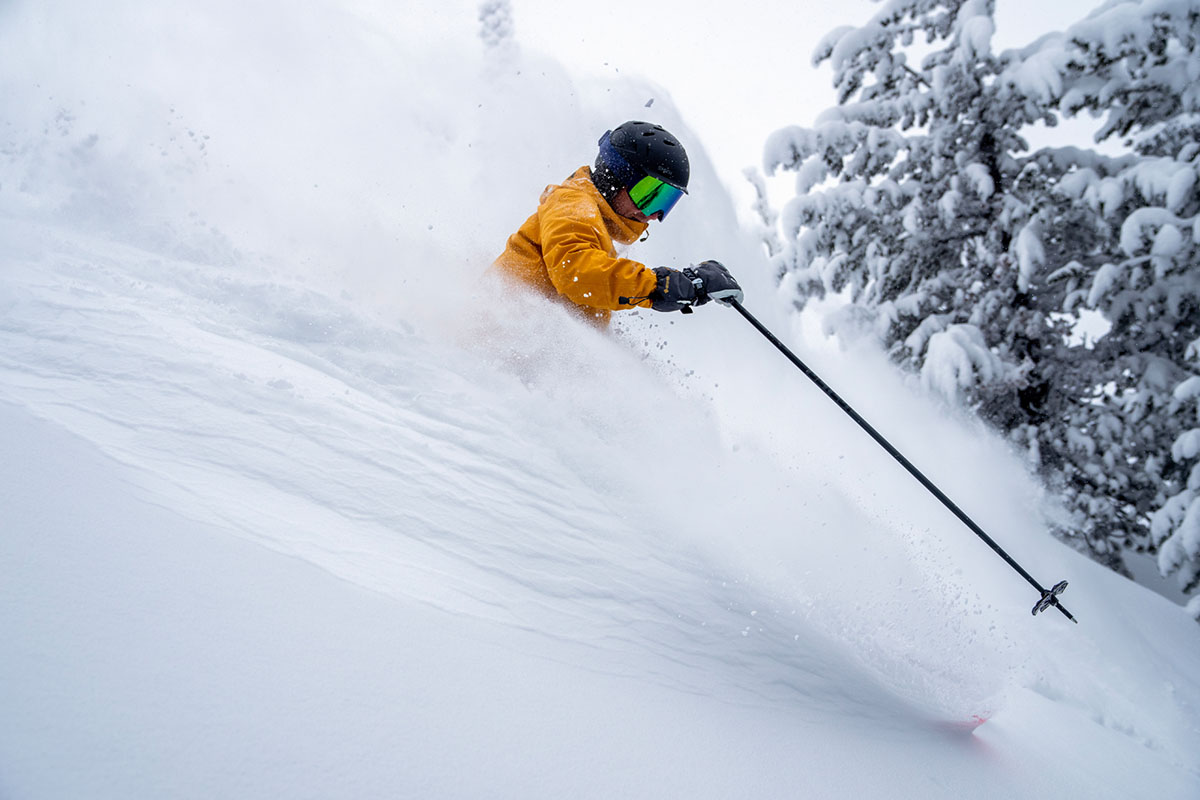
Carbon Fiber
High-end performance and backcountry ski poles often tout a lightweight construction, which, more often than not, is because there’s carbon fiber in the build. And not only is carbon fiber lighter than aluminum, it also has a natural flex under light pressure in contrast to the stiffer alloy. However, unlike aluminum, which bends under heavy stress, carbon may splinter and break. As such, it’s not the best material for folks who are hard on their gear or if you hit big features in the terrain park or do the occasional cliff drop. Those skiers would be better served by a quality aluminum pole.
It’s worth noting that only one of our backcountry picks (the Salomon MTN Carbon S3) is made exclusively with carbon fiber—most mix in aluminum either at the top or bottom of the shaft for increased durability. While skiing off-piste, it’s common to encounter obstacles like rocks and trees, which means your poles have to be able to withstand significant impacts. Resort-focused models, on the other hand, can get away with using all-carbon constructions because inbounds use is typically a bit easier on your gear (there are, of course, exceptions). Again, carbon is undoubtedly the lightest option, but make sure to consider the durability part of the equation, too, especially if most of your riding is done off-piste.
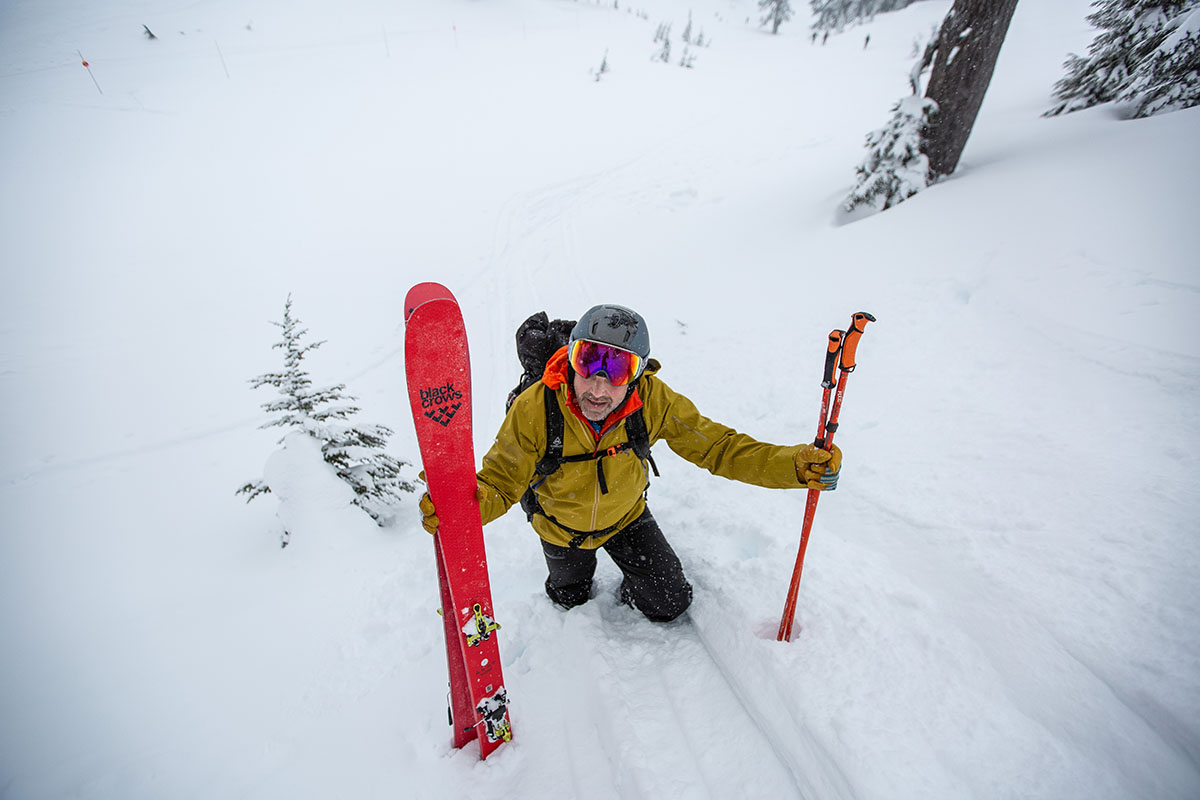
Bamboo
We’ve included a single bamboo model on our list above: the Grass Sticks Original Bamboo. Like aluminum, bamboo flexes under pressure rather than snapping, which translates to good all-around durability. But for many, the biggest draw is environmental: Compared to aluminum or carbon models, bamboo poles need to undergo far less processing and require less energy output to be manufactured and produced. So far, reviews are positive, but bamboo is still less proven from a long-term durability standpoint. If you’re looking for a tried-and-true option for resort use, aluminum remains the most reliable material (especially for particularly aggressive riders and park use).
Fiberglass
The least common material used in ski pole construction is fiberglass. This is mostly due to its primary constraint: low levels of durability (even lower than a comparable carbon, aluminum, or bamboo pole). The appeal of fiberglass is that it shares similar traits to carbon—lightweight with a tendency to flex under light pressure—but at a lower cost. As such, fiberglass is best when blended to increase its structural support. Hybrid aluminum/fiberglass designs reduce weight without compromising as much on durability.
In addition to material, shaft diameter is also important to consider and closely corresponds with durability. The models on our list above range from 14 millimeters (a couple designs employ dual-thickness shafts that are 12mm at the bottom) all the way up to 22 millimeters for the Black Crows Furtis, which is a considerable spread. In practice, a thinner design like the Leki Carbon 14 3D (14mm) is great for keeping weight low, but these poles aren’t all that robust for venturing off-trail where you’re likely to encounter rocks, trees, and other hazards. At the opposite end of the spectrum, stepping up to the 18-millimeter Völkl Phantastick, Evo Merge, or Black Crows Meta makes a lot of sense for aggressive riders or those who regularly hit the terrain park. And poles in the 14- to 16-millimeter range strike a nice middle ground between weight and toughness.
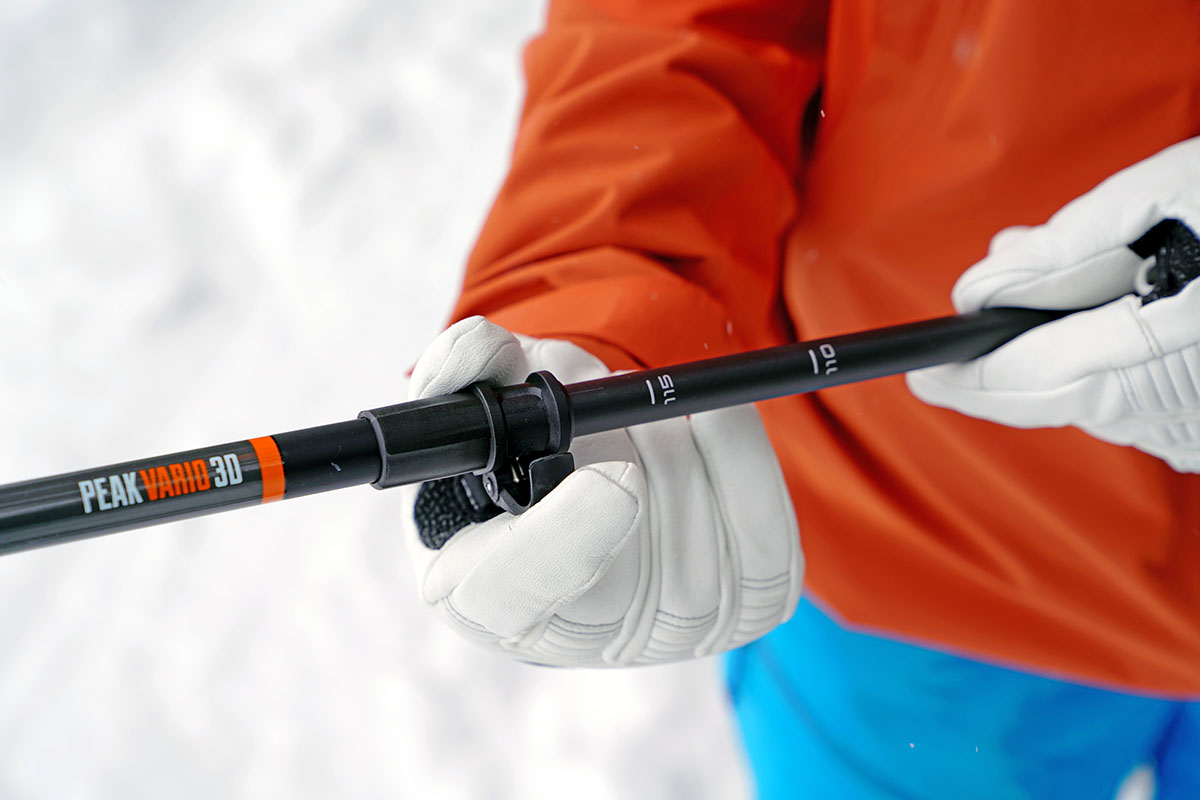
The weight of a ski pole is most important for backcountry or sidecountry skiers, but resort-goers can still appreciate the lighter feel. The weight of a ski pole most often correlates with material type, but that doesn’t mean you should assume a carbon pole will always be the lightest option. As we touched on above, the thickness of the ski pole’s shaft also plays a role. If you are comparing an aluminum and carbon pole (with similar features) and the carbon is heavier, you can reasonably assume the carbon pole has a wider diameter.
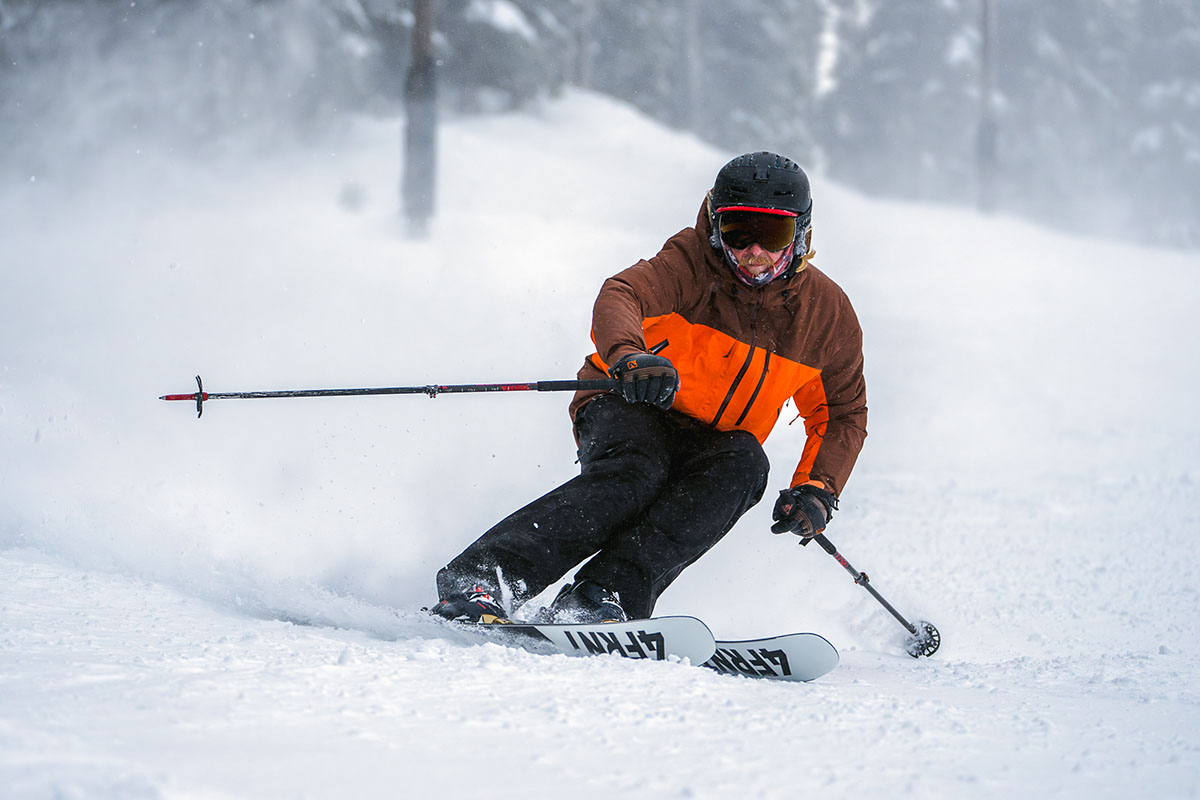
Narrower construction of any material type will be less durable and have a lower stress tolerance, and as a result, we rarely recommend finding the absolute lightest ski pole available. Our backcountry ski pole recommendations—even the relatively thin Black Diamond Razor Carbon Pro—are still tough enough to handle most ski conditions. Opting for an ultralight, all-carbon pole is a viable choice for those embarking on multi-day ski touring missions or skimo races, but expect durability and longevity to drop significantly. In the end, finding the right balance between weight and durability for your particular style of riding should be a key consideration in your ski pole purchase.
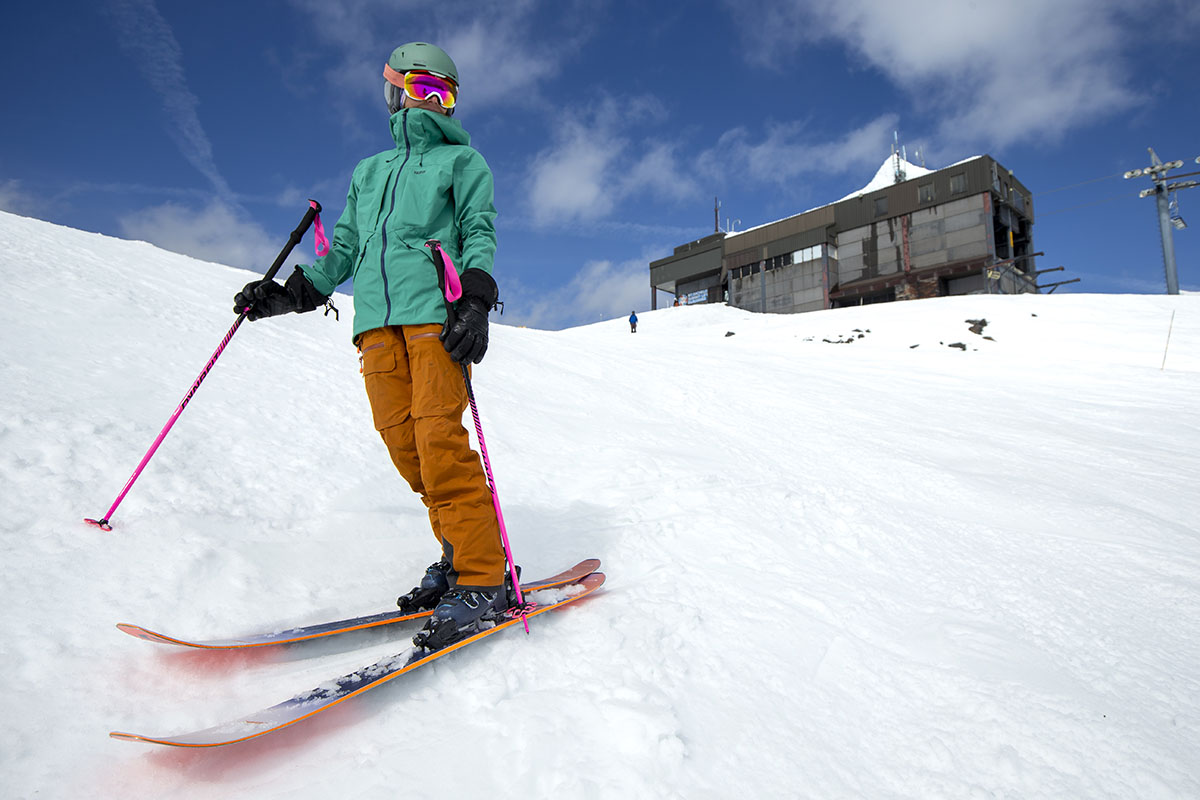
An adjustable ski pole is best for out-of-bounds use, and particularly when touring. The reasoning is fairly simple: You’ll typically want a shorter length for the uphill and longer for flat sections and downhill. Further, if you need to use your hands for scrambling or navigating up an icy slope with an ice axe, it’s nice to be able to compress your poles to stow them in or on your pack (a big reason we like the aptly named Black Diamond Traverse Compactor, which measures around 16 in. when collapsed). The main disadvantage of a telescoping pole is the possibility for the clamp to not hold and collapse unexpectedly when you plant. In addition, the separate sections create inherent weak points in the design for potential failure. Choosing a pole from a reputable brand with great locking mechanisms and top-quality materials is always a good idea, and make sure to test to ensure the clamps are properly tightened before heading out.

One exception above is the Folkrm Wyeast, which is part of a growing cohort of baton-style ski poles—fixed-length designs with extra-long grips. The benefits are multifold: You can shift your grip position depending on the terrain without having to stop to make adjustments, and the pole won't unexpectedly collapse under weight like some adjustable designs. On steep and consequential terrain, you can also plunge the pole upside-down to stabilize, pull yourself up, or create a makeshift deadman anchor. That said, baton poles do take some getting used to, and it may feel unnatural to have a good portion of the pole exposed above your wrist at first. They also don't collapse down for strapping to the outside of a ski backpack. In the end, we think most backcountry riders will be perfectly happy with adjustable poles, but designs like the Wyeast certainly have appeal for ski mountaineers and other backcountry-goers who are hard on their gear.

If you exclusively ride inbounds, a fixed-length model will save you some money over an adjustable design and have fewer moving parts that can break or fail over time. All of our resort picks above are of the non-adjustable variety since you won’t need to shorten your poles to travel uphill for significant stretches. And for those who split their time in and out of bounds but only want to purchase one pole, consider your priorities: Would you rather have a simple and reliable design, or do you prioritize the ability to adjust the length of your poles while touring?
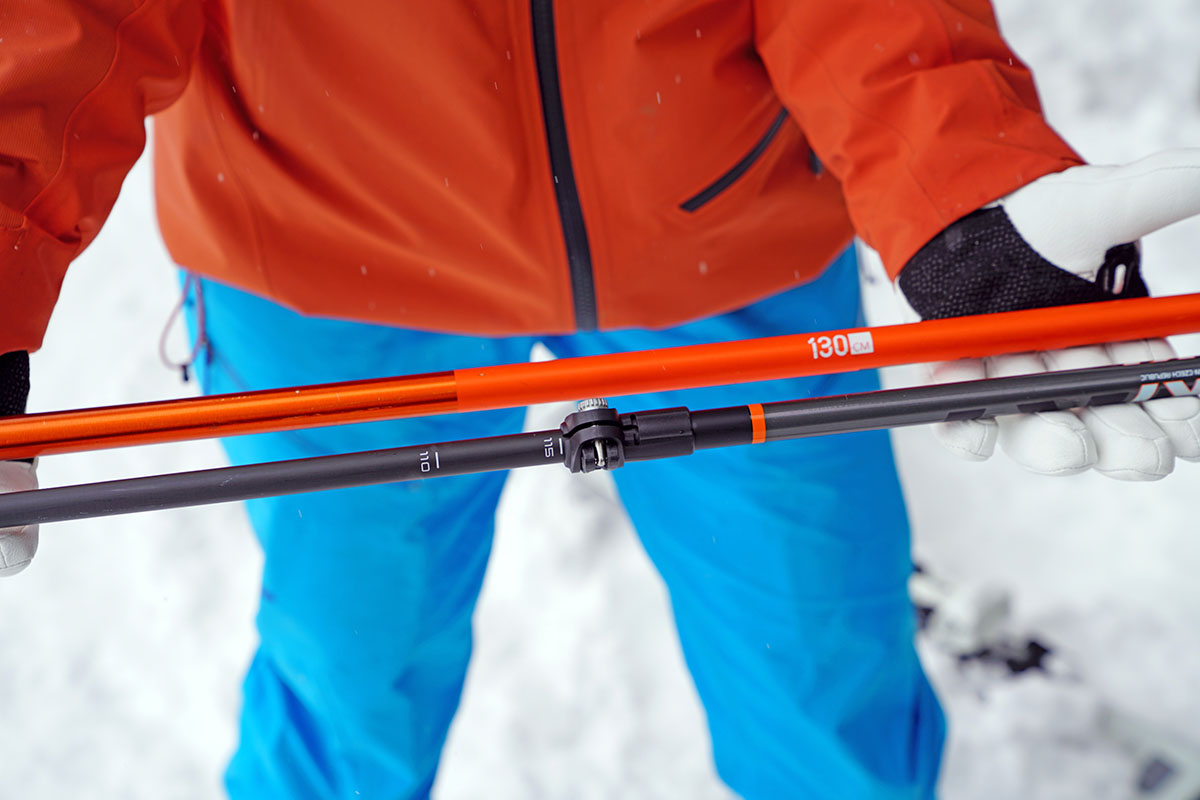
Grips
With a pretty wide variety of materials and shapes, choosing a ski pole grip will most often come down to personal preference and how well the grip fits in your gloved hands. The most common grip materials are plastic and rubber, in part because neither absorbs moisture. Rubber is the more comfortable of the two, and some poles have dual-density foam inside for increased hand comfort. Note that women’s-specific ski poles have smaller-diameter grips, which means not all women should automatically assume a women’s model is best (for more, see our section on Women’s-Specific Ski Poles below).
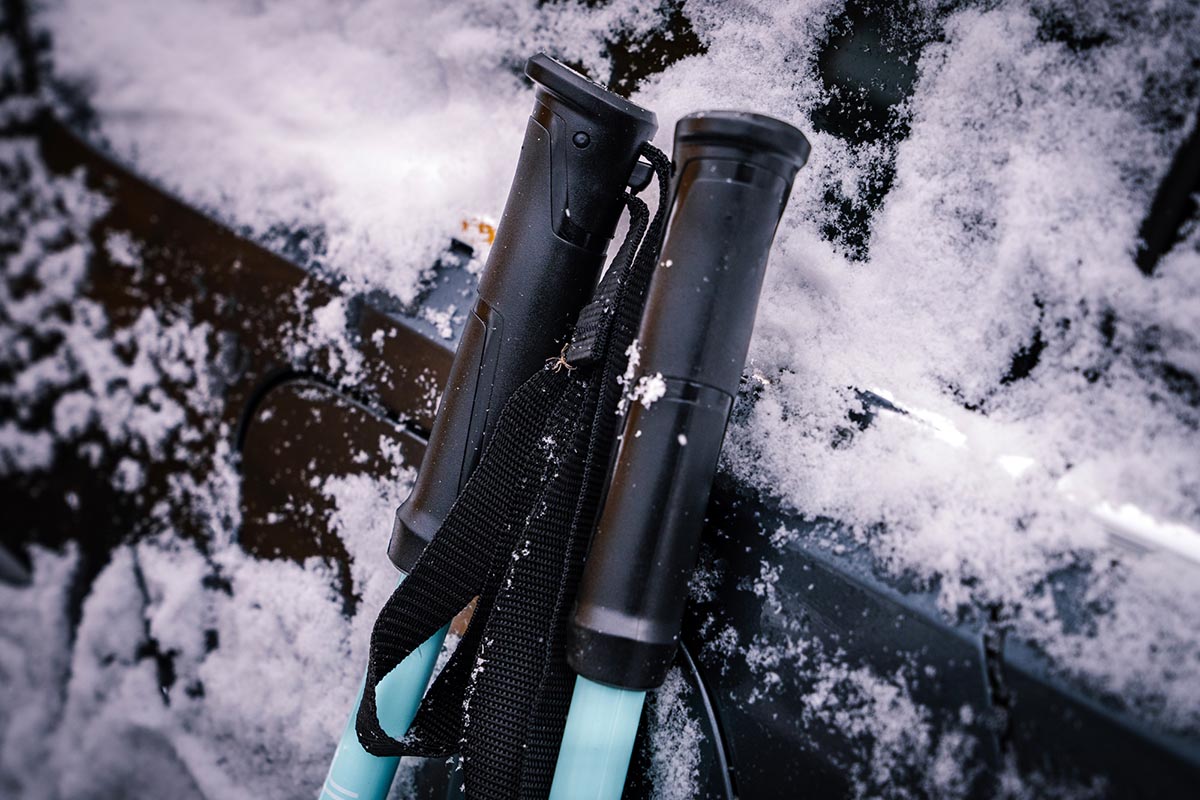
Some high-end models have grip extensions or metal rings that function as a place to choke up on the ski poles if you’re trudging up or traversing across a particularly steep section. This feature is usually found on backcountry poles and can be helpful for those who ski tour in varied terrain or bootpack up to a summit. At the extreme end of the spectrum is the Folkrm Wyeast, which boasts an extra-long foam grip that extends about halfway down the pole. With more surface area for you to grab, these long-grip designs make it easier to navigate steep and uneven terrain—great for sidehilling or bootpacking when you’ll be choking up frequently. It does result in a noticeably polarizing look and unwieldy feel on the descent, but riders who frequent particularly aggressive terrain may be willing to deal with that trade-off.
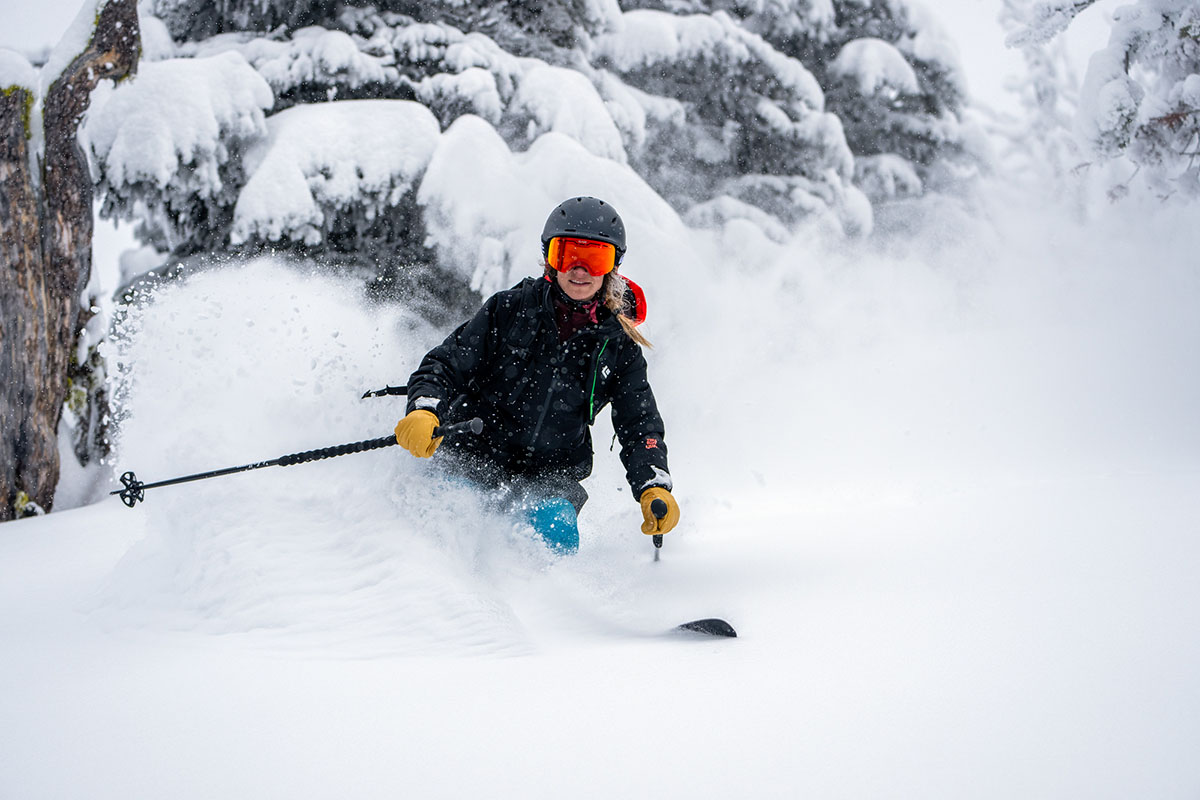
Straps
Tasked with the simple job of keeping the poles wrapped around your hands, the straps on a ski pole are most often made with a pretty basic nylon webbing. As long as the strap is wide enough for your ski gloves—we recommend looking for one that is easily adjustable—any old webbing style strap is all you need. Some high-end models have padding, which may be relevant for downhill racers or those who wear thin gloves.
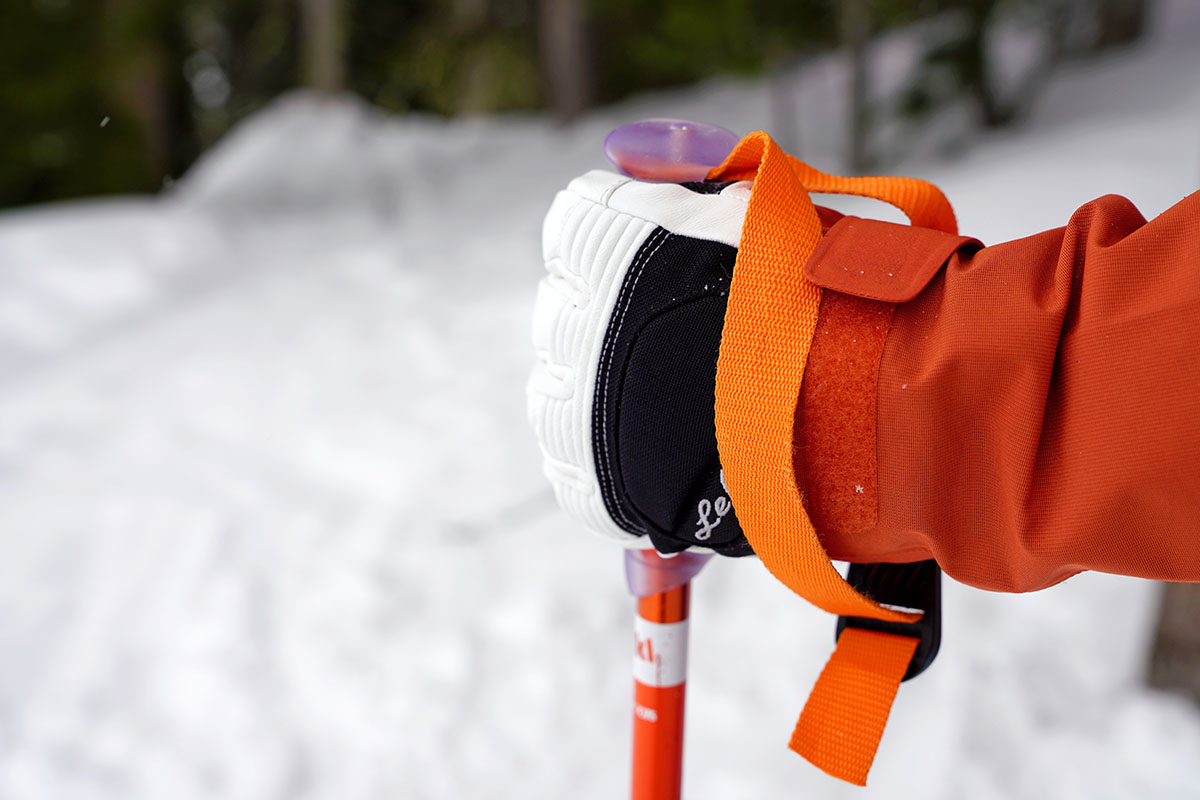
While on the topic, it’s worth pointing out that some brands incorporate added safety tech into the straps on their more premium models. For example, Atomic’s BCT Freeride uses their SQS (short for “Safety Quick Release System”), which is designed to disconnect the strap from the pole in the event of a snag or fall. It’s a similar story with Salomon’s S3 tech featured in their Polar Pro and MTN Carbon S3 models. Leki takes it a step further with their Trigger S system seen in the Detect S and Carbon 14 3D: Instead of having to take the straps on and off in the lift line, Leki's straps remain around your wrists and can be connected to the ski poles via a small fabric loop. A push of a button along the top of the grip lets you release the straps from the poles, and, in a crash, the poles will disconnect from your wrists under upward pressure. Some will enjoy the simplicity of the design—as well as the extra safety measure—but whether these features are worth the bump in cost (usually $20-$30 extra) will come down to your priorities as a skier.
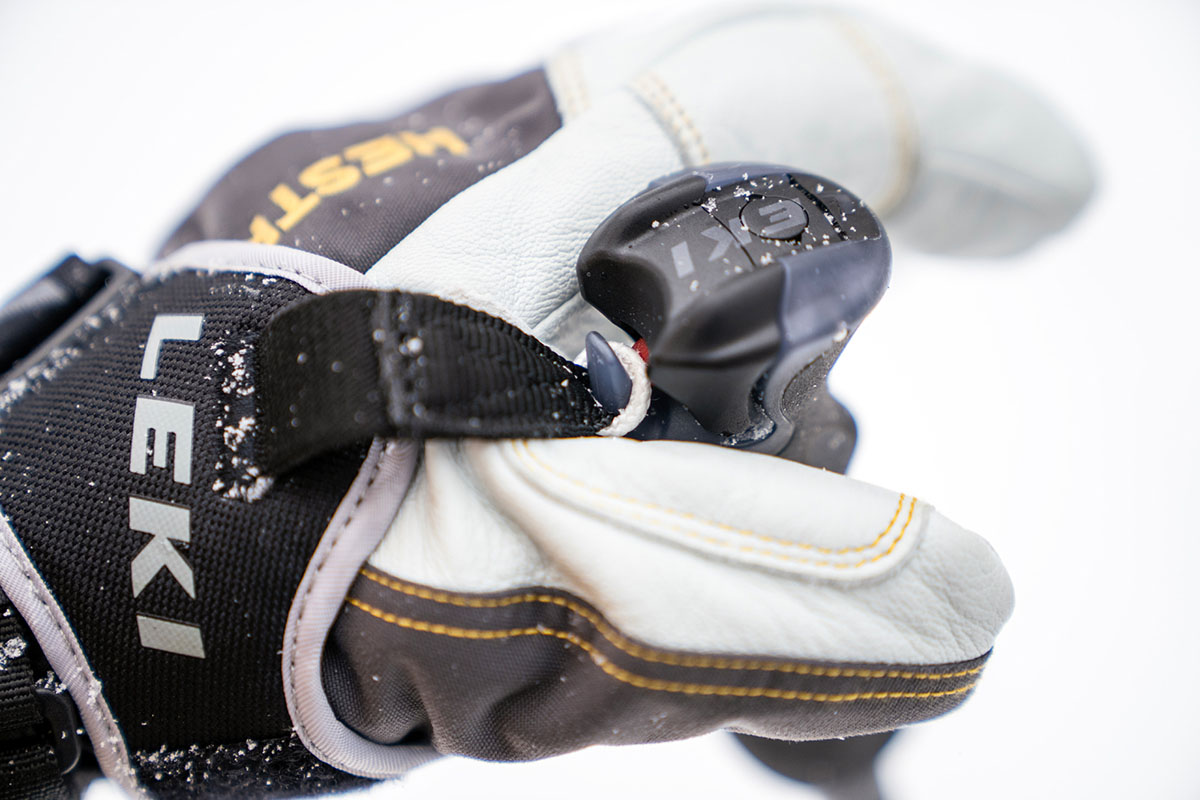
Powder and Standard Baskets
All ski poles have a plastic circular basket connected near the bottom to keep a planted pole from sinking too deeply into the snow. These plastic (or sometimes aluminum) baskets come in varying circumferences, but can be broken down into two general categories: powder and standard (hardpack).
Powder baskets have a greater surface area to keep the poles from sinking as far into the snow when you plant. The circumference of these poles ranges between models and brands, but is approximately 90-100 millimeters (about 3.5 to 4 inches). Standard baskets, also referred to as hardpack or groomer baskets, are what come with most downhill-focused poles and are smaller in diameter. If your ski area gets a mix of snow types or you find yourself spending some days on groomers and others in the side or backcountry, a ski pole with replaceable baskets may be worth it. The Leki Detect S is an example of a pole that has this option: You simply swap out the baskets to match the snow conditions.
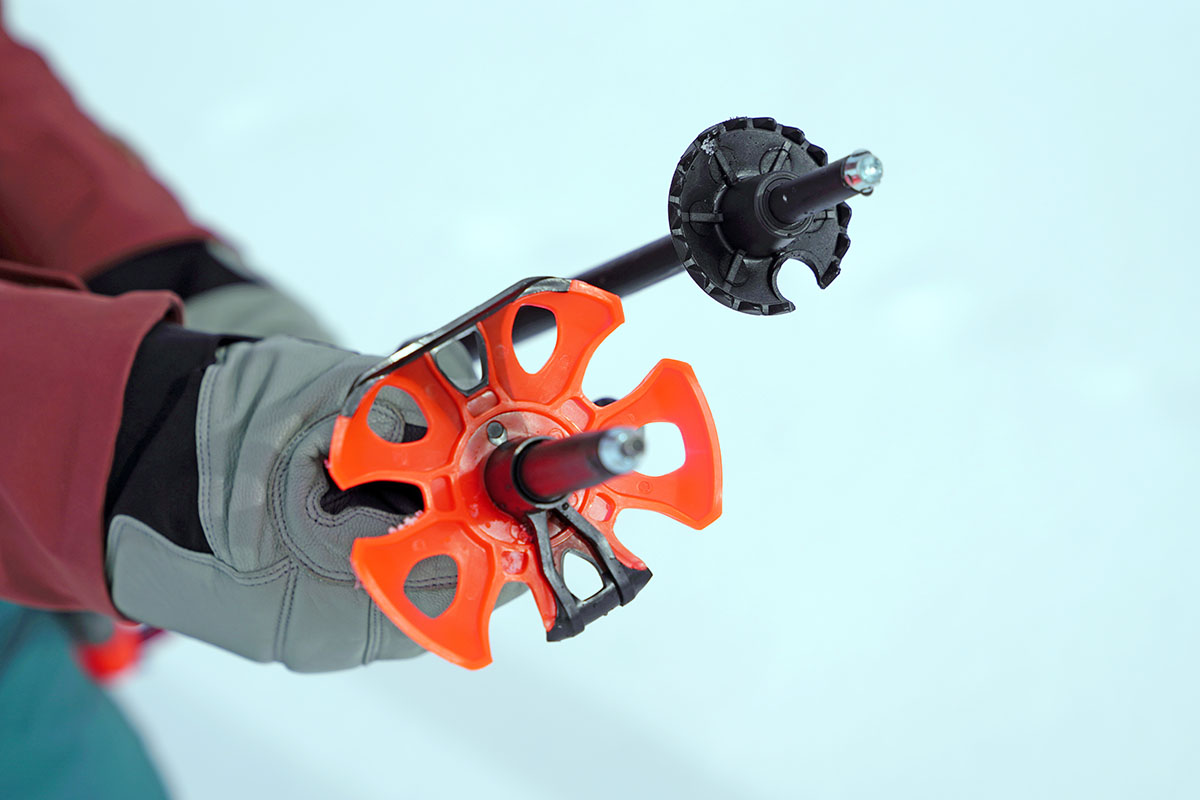
In addition to variations in grips, straps, and baskets, some ski poles include additional features that set them apart from the competition. From our list above, notable additions include the stainless steel pick on the front of Black Diamond’s Carbon Whippet for self-arresting and the hooked tip on the Dynafit Tour, Black Diamond Traverse, and Traverse Compactor for tweaking heel risers or scraping snow off of skis and skins. We did our best to call out any unique and noteworthy features in the write-ups above, as they can be a big help for the right user and activity.
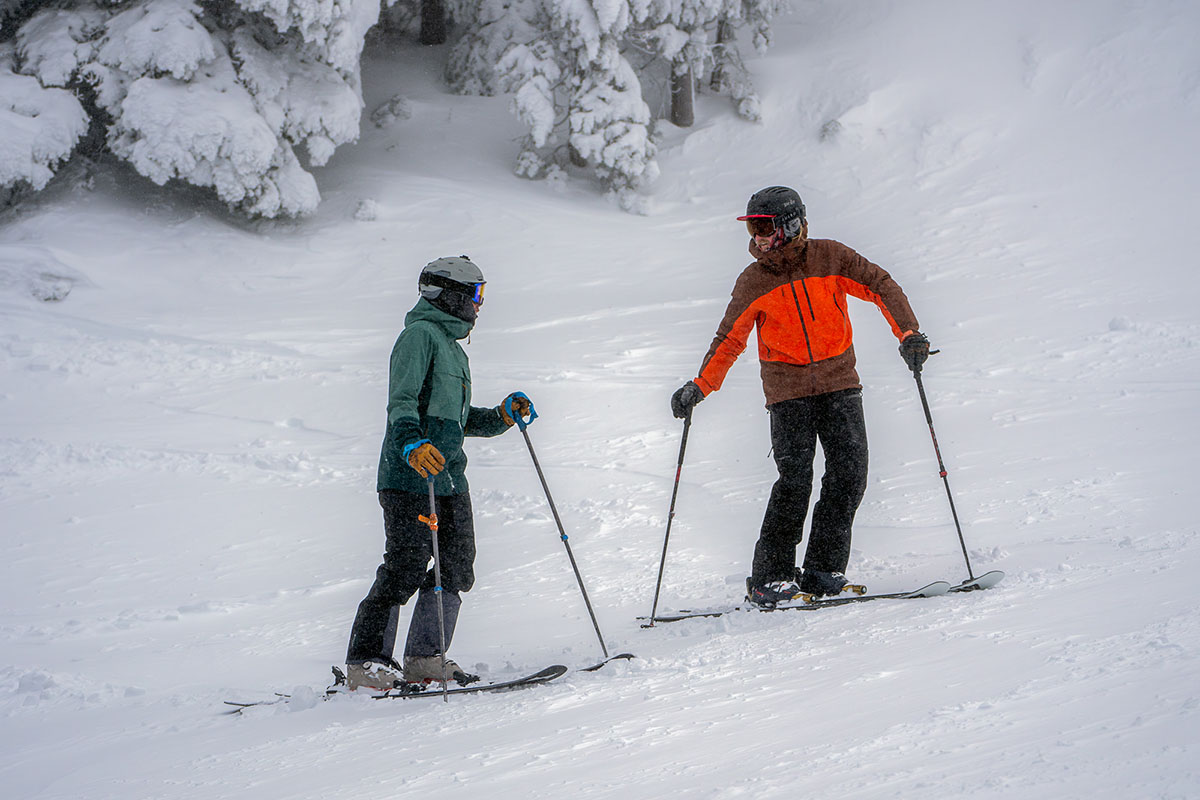
Only one model to make our list this season is offered in a dedicated women’s version, the Völkl Phantastick, though we take a bit of issue with this, as it's not the same pole as the men's version: The women's Phantastick is only offered in a 16-millimeter shaft diameter, while the men's comes in 18-millimeter. We aren't big fans of brands assuming that women always weigh less, are smaller, or don't charge as hard as men. That's simply not true. And in any case, as we touched on above, most women’s poles are largely similar to their unisex counterparts apart from a couple key differences. These include smaller-diameter grips that are designed to fit smaller hands, along with shorter length options to choose from. Many women’s-specific designs also come in different colorways, although we’re thankful that the “shrink it and pink it” strategy of old has mostly gone out of vogue. In our opinion, fit and feel matter more than gender designation—shorter folks with smaller hands may prefer a women’s-specific design, and we see tons of women on the slopes sporting unisex poles (most of our female editorial staff included).

It’s very important to take the time to choose a ski pole that is the proper length for your height and skiing style. A ski pole that is either too long or too short will impact your ability to smoothly transition between turns and can even knock you off balance. Most online charts use a conversion for total height, and this is a good starting point, but we encourage you to go a step further. For traditional downhill, the measurement should place the grips in your hands with your arms bent at a 90-degree angle. You can get this measurement using a simple measuring tape—and don’t forget to throw on shoes (or your ski boots) to get a more exact number. Backcountry and terrain park use requires a shorter pole, and for more details on getting sized for these skiing types, we recommend watching this video put together by ski retailer Evo.
Back to Our Top Downhill Ski Pole Picks Back to Our Top Backcountry Ski Pole Picks